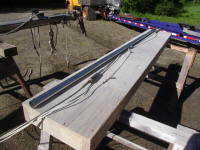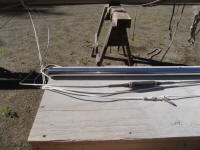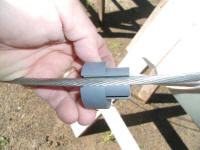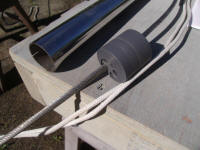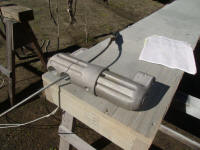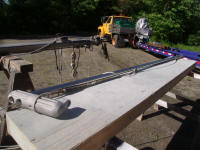
110 Cookson Lane | Whitefield, ME 04353 | 207-232-7600 | tim@lackeysailing.com
Summer Song | Wednesday, June 11, 2014
The owner purchased a GPS/chartplotter and radar unit for the boat, along with a backstay radome mount, and with these items now on hand it was time for installation. To begin, I laid out all the various parts.
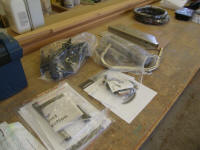
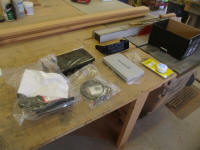

The "universal" mounting plate included with a swing-arm mount for the plotter did not allow mounting of the plotter's bracket without modification: the bracket was too long. So I used a piece of 1/4" acrylic to create a transition piece, allowing me to bolt the bracket in place as needed.

I began with portions of the radar mounting pole, which included a long stainless steel pole that would mount along the backstay and support a gimbaled mount for the radome. Earlier, I'd installed a deck bracket for this pole mount. Now, I followed the instructions to install the gimbal mount and pole as needed.
Next, I assembled the mounting plate and tested its fit. For transport, and since I could choose to run the cables in the boat (which is what I planned to do) or up the radar pole--but not both at this time--I did not finalize installation details for the mount and radome now. I did trial-fit the radome to the place, and determined that the included mounting studs were much too long for this specific installation, so I ordered shorter bolts that I'd use to install the dome later. Meanwhile, final cable connection details would have to occur once the rig was stepped. For now, I removed the rotating mount and secured the pole and backstay to the mast for storage and transport.
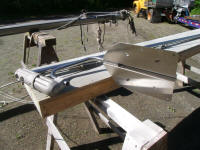
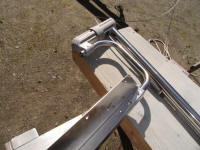
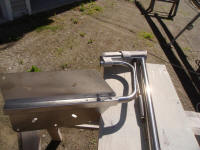
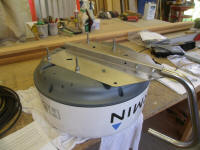

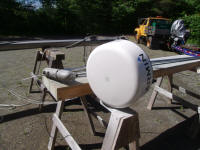
On the boat, I began by installing a through-deck cable mount for the two cables (power and network) required for the radome. I located this just forward of the deck mount for the pole, and left ample cable available above deck for the final connections. Later, excess cable not needed above deck could be led below and tied up there as needed.
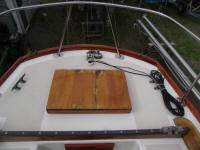
Belowdecks, I led the two cables forward: network cable along the starboard side, and into the cabin where I'd be installing the plotter itself; and the power cable along the port side where I could connect it to the existing electrical service panel. I left the cables loose for now pending final connections in a bit.
The owner selected an aluminum swing-arm mount for the plotter, and after various considerations I mounted it to the inside of the companionway trim below a protruding cabinet above, since mounting it higher would have not allowed sufficient headroom for the mount and plotter itself. My mounting location required a small trim block, which I'd made earlier from mahogany, to allow the mount to be installed flat with the companionway trim.
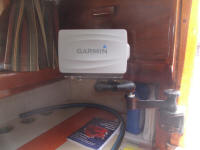
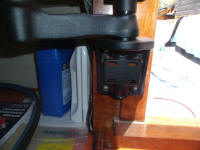
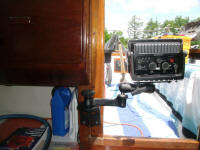
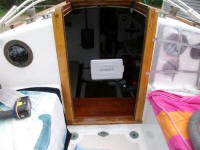
With the plotter and swing arm installed, I led in the network cable from the radome, and the GPS/plotter power cable, securing them to the back of the plotter and along the mount and nearby areas as needed, protected with split loom and with enough slack to allow the swing arm to swing.
After leading the GPS power cable into the port cockpit locker, where the electrical service (fuse panel) was located, I connected it--along with the power leads from the radome--to a new terminal block, then to a ready source of power off the existing panel (circuit 5, labeled "log" on the panel). Each individual component (plotter and radome) featured its own inline fuse, but I also installed a new fuse in the appropriate place at the back of the existing panel, since I couldn't determine the size of the existing one and wanted to ensure that the new loads from the electronics wouldn't overwhelm the old one. Once I had the cable leads the way I wanted them, I could secure the cables inside the various spaces of the boat as needed, and tie up the excess.
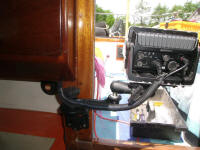
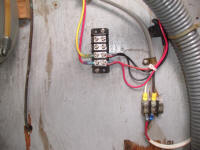
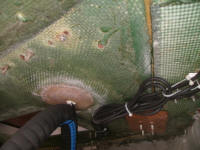
During engine installation several months ago, I'd removed many extraneous wires--and, inadvertently, one critical one: the wire connecting the negative distribution buss with the battery. This rendered the panel inoperable till I ran a new replacement (the large yellow wire seen in the photo). This done, I could power up the GPS for the first time. This unit featured an internal antenna that, at least on this brief test, seemed to operate well. The radar would operate on the same screen.


I had a few items remaining on my work list, and would take care of them in the near future, but the plotter and radome installation had been the largest items on the list and it was good to have their installation complete. Before knocking off, however, I installed four screws to secure the lazarette hatch hinges to the hatch itself.
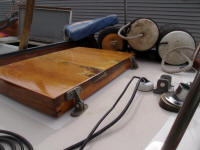
Total Time Billed on This Job Today: 8.75
Hours
